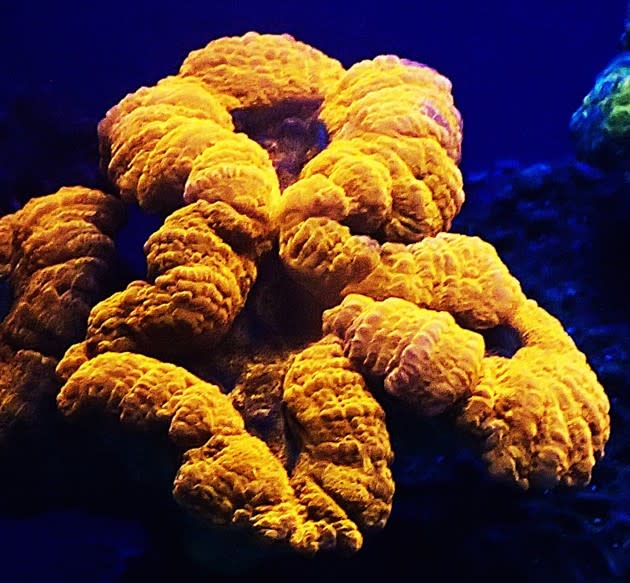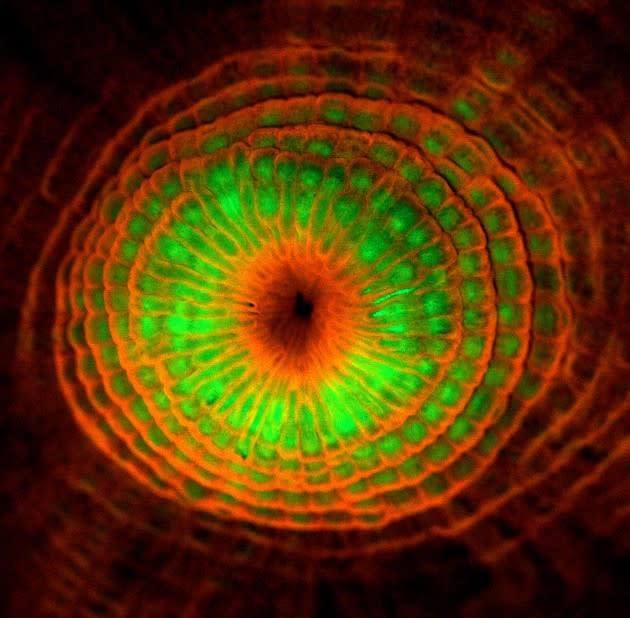Why Do Corals Glow in the Dark?
It’s one of the ocean’s most beautiful and striking mysteries: Why do corals fluoresce?
In shallow waters, they glow a brilliant pink and purple. In deeper waters, corals turn red and green against a dim blue background. The view is most unforgettable at night with a flashlight and mask filter, when the fluorescent corals provide a “psychedelic adventure.”
Jörg Wiedenmann, a coral reef scientist at University of Southampton, had previously found that the pink and purple fluorescence in shallow waters act as a kind of sunscreen. The fluorescent pigments absorb damaging wavelengths of light and emit it as pink or purple light, protecting the single-celled organisms called zooxanthellae that live symbiotically inside coral. Zooxanthellae are photosynthetic and they provide the coral with food in exchange for shelter.
This “sunscreen” effect was interesting, but it didn’t explain why corals fluoresce in deeper water, where light was not intense enough to harm zooxanthellae. In fact, in those dim blue waters, the problem was more likely too little light. Wiedenmann and his colleagues now have a new study, in which they present a novel function for deep water fluorescence. And again, it has to do with the zooxanthellae: Coral may be converting blue light into orange-red light that penetrates deeper into the coral tissue, where photosynthetic zooxanthellae live. Fluorescence, by definition, is the absorption of light in one color and the emission in another.

There’s something elegant in these explanations if true. So intertwined is the coral-zooxanthellae relationship that fluorescence is the result of two species living and working together.
Recommended: Are We as Doomed as That New York Magazine Article Says?
But there’s a counterintuitive part too. In the Red Sea, the blue to orange-red fluorescent pigment only appeared in corals deeper than 40 feet. Here, blue light dominates because the other wavelengths are absorbed by water. Zooxanthellae also happen to be good at using blue light for photosynthesis. So why would corals use fluorescent pigments to transform blue light into orange-red, a color not as easily used by zooxanthellae for photosynthesis? “We and others were long puzzled by the fact,” Wiedenmann wrote in an email.
But when the team looked more closely, they found another possible explanation. Blue light may be good at penetrating water and for photosynthesis, but it doesn’t penetrate the coral’s tissues well. And zooxanthellae can live deep inside coral.
To these observations, Wiedenmann and his team added a long-term experiment. They grew two species of coral in a lab for two years. Only some of the corals were fluorescent. The fluorescent ones survived better than the ones that were not.

“This is a very elegant study,” says Michael Kühl, a marine biologist at the University of Copenhagen. Kühl has also studied how coral shells and tissues affect light that reaches zooxanthellae and he says he’s eager to take a look for himself. “I am looking forward to getting my hands on corals harboring the photoconvertible host pigment,” he says.
Mikhail Matz, a coral scientist at the University of Texas at Austin, says he’s not yet convinced this completely explains the function of the fluorescent pigment in deep water corals . As humans with eyes, we tend focus on the light coming from these coral. But maybe the glow isn’t the point. “The fluorescence may not be the important aspect. It could be a side effect,” he says. It could be that fluorescent proteins are actually there just to absorb light as the part of some metabolism, and the glow that we see is incidental to its true purpose.
And yet, at some stages in the life cycle, fluorescent proteins are the most abundantly expressed light-absorbing protein in the entire coral. Whatever their true purpose, the glowing coral proteins appear to be important.
Read more from The Atlantic:
This article was originally published on The Atlantic.
